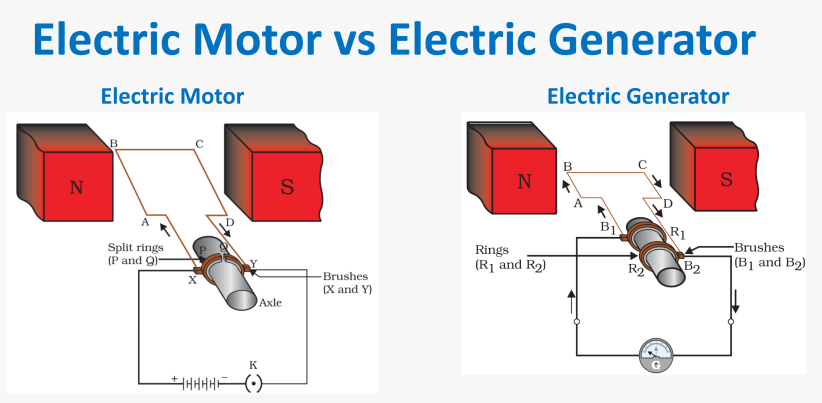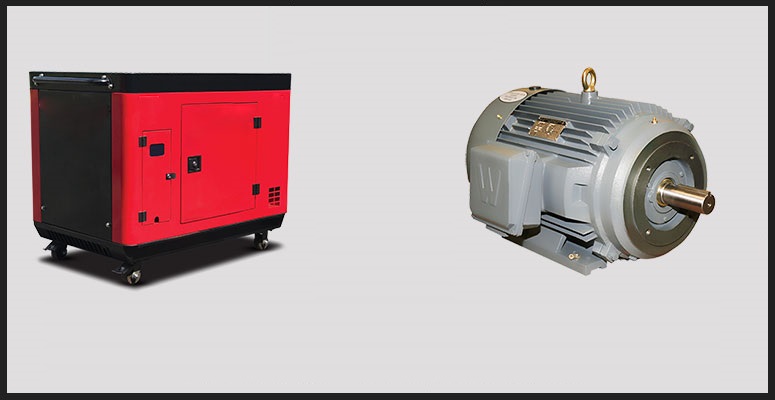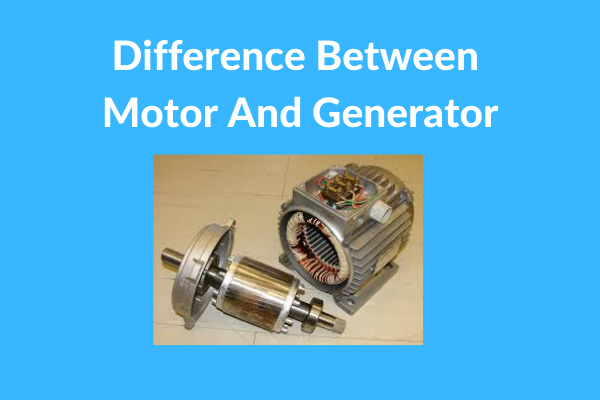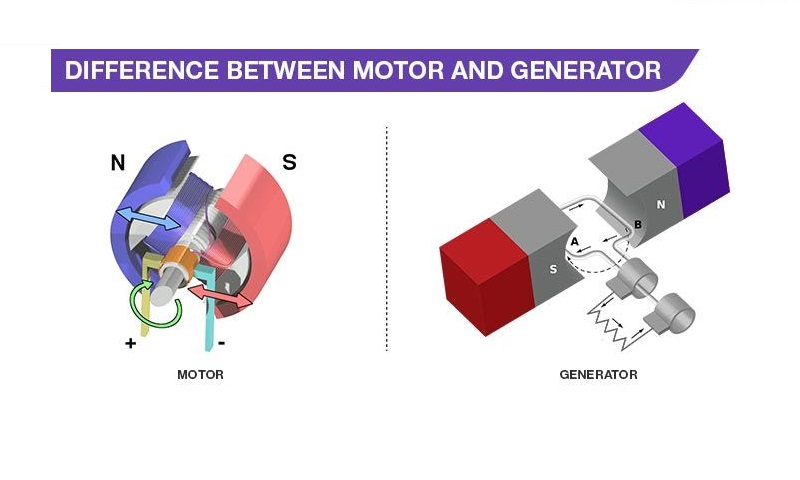Differences Between Motor and Generator- The electric motor and generator can be comprised based on different features like the basic principle of working or function of these instruments. Production or consumption of electricity, the existence of the current in the winding, and their driven element are the important factors to determine the differences between motor and generator. Both the motor and generator follow Fleming’s rule in their principle.
What are the Main Differences Between Motor and Generator?
Electric motors and generators have considerable differences in their function and what they are utilized for, but both are closely joined to Faraday’s Law to support the electromagnetic induction principle.

Once an experimental novelty, electricity is now an important part of our modern life. Electricity presents climate control, lighting, entertainment, and more. Energy is transformed from other types into electricity to provide electrical power, powering the devices and systems for people.
Converting energy from one type to another is the important key to comprise the differences between motors and generators. An electric motor transforms electricity into mechanical energy, providing an energy source for machinery. A generator operates based on the opposite of this, transforming mechanical energy into electrical type.
Despite this considerable difference in performance, electric motors and electric generators are closely related by their fundamental structure and underlying mechanisms. Both rely on the basic law of physics: Faraday’s Law.
Faraday’s Law of Electromagnetic Induction: Electricity and magnetism
Today, it’s well understood that electricity and magnetism are two sections of a single fundamental phenomenon, introduced as electromagnetism.
In 1831, physicist Michael Faraday found electromagnetic induction, revealing an important relationship between the observed phenomena of electricity and magnetism. Interestingly, in 1832, another physicist, Joseph Henry, found it independently. Faraday was the first to combine his findings, and to this day, he is credited with this detection. Later, James Clerk Maxwell would find a method to mathematically formulate Faraday’s findings, leading to the development of the Faraday-Maxwell formula.
Faraday’s Law of Induction is a physics law presented to predict accurately and detect how a magnetic field will interconnect with an electric circuit to generate an electromotive force (EMF). EMFs transform other types of energy, such as mechanical form, into electricity. This physics law is what permits us to make both electric motors and generators. While these two forms of machinery operate based on the opposite functions, they both rely on the same underlying physics laws.
Both the motor and generator come under the category of machines. The main difference between motor and generator is that a motor transforms electrical power into mechanical form, while the generator does the exact opposite. The motor utilizes electricity, while the generator generates electricity. Let us know more about the differences between motor and generator by going into their basics.
The difference between motor and generator is likely the most typical question from the electricity aspect of physics. In this post, the main differences between motor and generator are given. Before explaining the differences between motor and generator, it is essential to learn what they basically are, their structure, functions, and other related details. To learn more about the differences between motor and generator, visit here.
What is Motor?
A motor is a type of electrical machine that transforms electrical energy into a mechanical one. Electric motors are energized either from direct currents (DC sources), including motor vehicles, batteries, or rectifiers, or from alternating currents (AC sources), including inverters, power grids, or electrical generators.
Electric Motors: From Electrical Energy to Mechanical Energy
An electric motor performs based on a simple principle. Instead of converting mechanical power into electricity, an electric motor takes electrical energy and converts it into mechanical output. Electric motors can be found in a wide range of applications, from everyday household appliances to industrial manufacturing machinery.
The rotor circulates the shaft to generate mechanical power. The stator is constructed from permanent magnets, or coil windings, with a core of thin discs, joined together. These layers generate less energy loss than a solid core introduced as the laminations. There is a small air gap between the rotor and stator, which helps improve the magnetizing current.
While electric motors can be electrostatic, piezoelectric, or magnetic, the vast majority of new motors utilize magnets. Some are modeled to operate on DC, while others employ AC. You can use electric motors in different sizes in an impressively broad range of applications. From massive electric motors that power industrial manufacturing machinery to tiny motors in battery-powered watches, this robust yet elegant piece of technology is vital in our modern life as we understand it.
What is a Generator?
A generator operates with a reversed path of power, transforming mechanical energy into electrical one. Before learning about the differences between motor and generator, it is vital to know the details of current and voltage thoroughly.
Electric generators: Converting Mechanical Energy into Electric Energy
According to Faraday’s Law, whenever there is a modification in the magnetic field within a conductor, like a wire coil, electrons can move perpendicular to that magnetic environment. This produces an electromotive force, which generates a flow of electrons in one direction. This phenomenon can be employed to generate electricity in the generator.
The magnets and the conductor are moved relative to one another to produce this magnetic flux. The wires are connected to the tight coils, rising the number of wires and the output electromotive force. Continuously circulating either the magnet or the coil while keeping the other in place gives the constant flux variation. The moving part is referred to as a rotor, while the stationary section is called the stator.
Electric generators fall into two wide types: “dynamos,” which produce direct current, and “alternators,” which create alternating current. The dynamo was the first type of generator that was applicable for industrial usages. It was invented independently by several people during the Industrial Revolution. The electric dynamo utilizes the circulating coils of wire and magnetic fields to transform mechanical energy into DC. Dynamos were utilized for energy generation, usually using steam as the source to create the needed mechanical energy.
Today, the electric dynamo has few applications outside of a few low-energy uses. Alternators are far more common for the generation of electricity. This form of generator transforms mechanical energy into AC sources. A rotating magnet is introduced as the rotor, rotating within a set of conductor coils on an iron core, introduced as the stator. As the magnetic field produces, it creates an AC voltage in the stator. The magnetic field can be produced either by a field coil electromagnet or by permanent magnets.
An automobile’s alternator, as well as the main power sources that support electricity for a grid, are electric generators.

Definition of the Motor
Motor performs by the coordination between the electric current in a wire winding and the motor’s magnetic field to produce force in the torque form applied on the shaft. An electric motor operates on a continuous moving or for linear movement over a considerable distance compared to its size. It performs on three different physical methods: electrostatics, magnetism, and piezoelectricity.
Classification of Motor
AC Motor
It can easily transform the alternating current into mechanical output. We further categorize it into three forms; they are induction type, synchronous type, the linear type.
- The induction motor is further categorized based on the rotor, including the Phase Wound Rotor and the Squirrel Cage Rotor, and the basis of phase including Single-phase form and Three-phase form.
- Linear motor
- Synchronous Motor, which is further classified as the Reluctance Motor and Hysteresis Motor
DC Motor
It can simply transform DC power into mechanical output. It is divided into two main forms:
- Separately Excited type
- The self-Excited type is further classified as the Series motor, Shunt motor, Compound wound motor, Long Shunt motor, and Short Shunt motor.
Definition of the Generator
The generator converts mechanical energy into electrical output to employ in an external circuit. Sources of mechanical power include gas turbines, water turbines, steam turbines, etc. There are two widespread categories of electromagnetic generators, including dynamos and alternators.
Dynamos produce a pulsing direct current within a commutator, while alternators produce alternating current.
Specialized Types of Generator
Direct current (DC)
A dynamo employs commutators to generate direct current. It is also self-excited.
- One such form is the Homopolar generator. This is a DC electrical system containing an electrically conductive disc or cylinder moving in a plane perpendicular to a uniform magnetic field.
- Another one is the Magnetohydrodynamic (MHD) generator. It can directly extract electric energy from moving hot gases within a magnetic field without the use of moving electromagnetic systems.
Alternating Current (AC)
The induction device mechanically rotates the rotor quicker than the synchronous speed, providing a negative slip.
Linear electric generator: In this type, a moving magnet slides forth and back within a solenoid – a spool of copper material, which in turn stimulates an alternating current into the wire.
Variable-velocity constant-frequency generators: These generators can be used to harvest natural resources of mechanical power (tides, wind, etc.) to generate electricity.
Main Differences Between Motor and Generator

Definition
An electric motor is a device that transforms electrical energy into mechanical one, while an electric generator is an instrument that transforms mechanical power into electrical one.
Rule
A motor follows Fleming’s left-hand rule, while an electric generator operates based on Fleming’s right-hand rule.
Principle
The working principle of the motor depends on the current-carrying conductor that uses a force when it is kept in the magnetic environment. However, the working principle of the generator is based on the electromagnetic phenomenon.
Driving Force for Shaft
The shaft of the motor is driven by magnetic power, which is improved between the armature and field. The shaft of an electric generator is attached to the rotor, which is driven by mechanical power.
Source of Energy
Power grids and electrical supply are the energy sources of the motor. While water turbines, steam turbines, and internal combustion engines are the main sources of the generator.
Current Usage
In a motor, the current is provided by the armature winding. In contrast, current is generated in the armature winding in a generator.
Types
DC Brushed Motors, Linear Motors, DC Brushless Motors, Direct Drive, AC Brushless Motors, Servo Motors, and Stepper Motors are the main types of motors. Three basic forms of generators are portable, inverter, and standby.
Example
Ceiling fans, cars, etc., are all examples of motors. At the same time, the generator is commonly employed to produce electricity in power stations.
Key Differences Between Motor and Generator
- The Motor transforms electric power into mechanical energy, while the generator does the opposite.
- Electricity is employed in the motor, but the generator creates the electricity.
- The Shaft of the motor is run by the magnetic force produces between armature and field windings, while in the case of the generator, the shaft is connected to the rotor and is run by mechanical power.
- The current should be supplied to the armature windings in a motor, and in the generator, the current is created in the armature windings.
- The motor operates based on Fleming’s Left-hand rule, while the generator follows Fleming’s Right-hand rule.
- An example of a motor is an electric bike or car where electric current is presented to the system or device, and it gets transformed into mechanical motion and, as a result, the car or bike can be used. An example of a generator is that in the energy stations, the turbine is employed as an instrument that transforms the mechanical force of water falling from the dam to produce electricity.
These are the major differences between motor and generator. An appropriate selection can be made between motors and generators based on the requirements, applications, and type of power supply.
Buy Equipment or Ask for a Service
By using Linquip RFQ Service, you can expect to receive quotations from various suppliers across multiple industries and regions.
Click Here to Request a Quotation From Suppliers and Service Providers
Read More on Linquip



